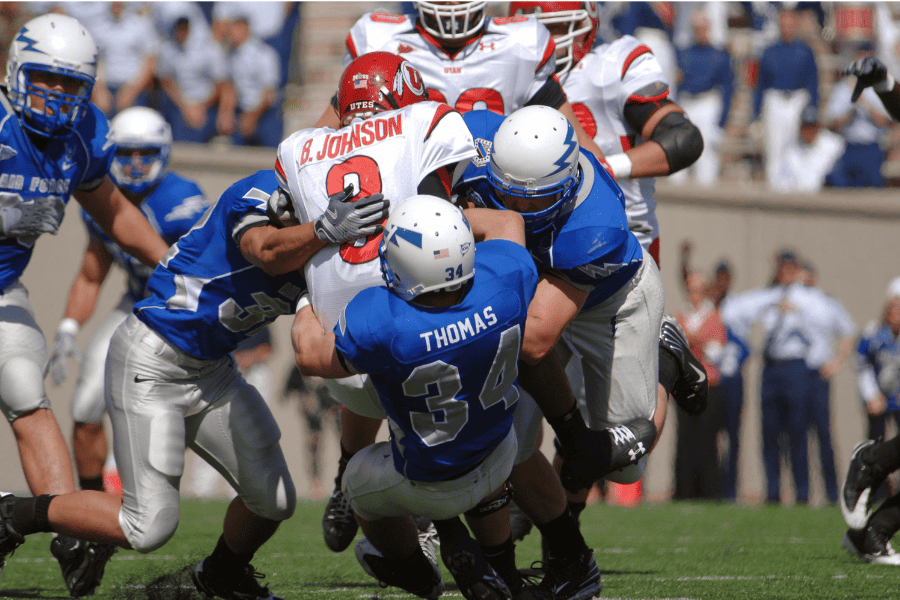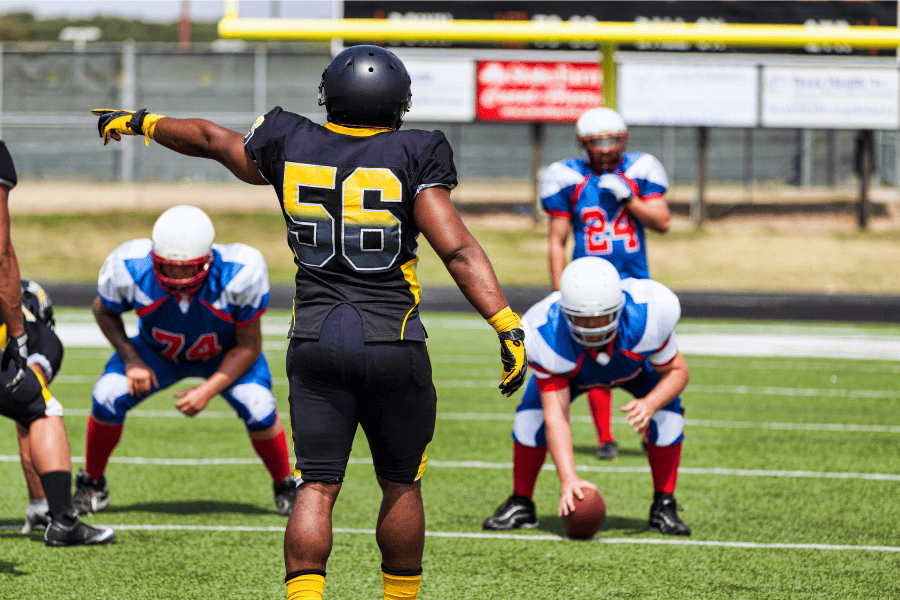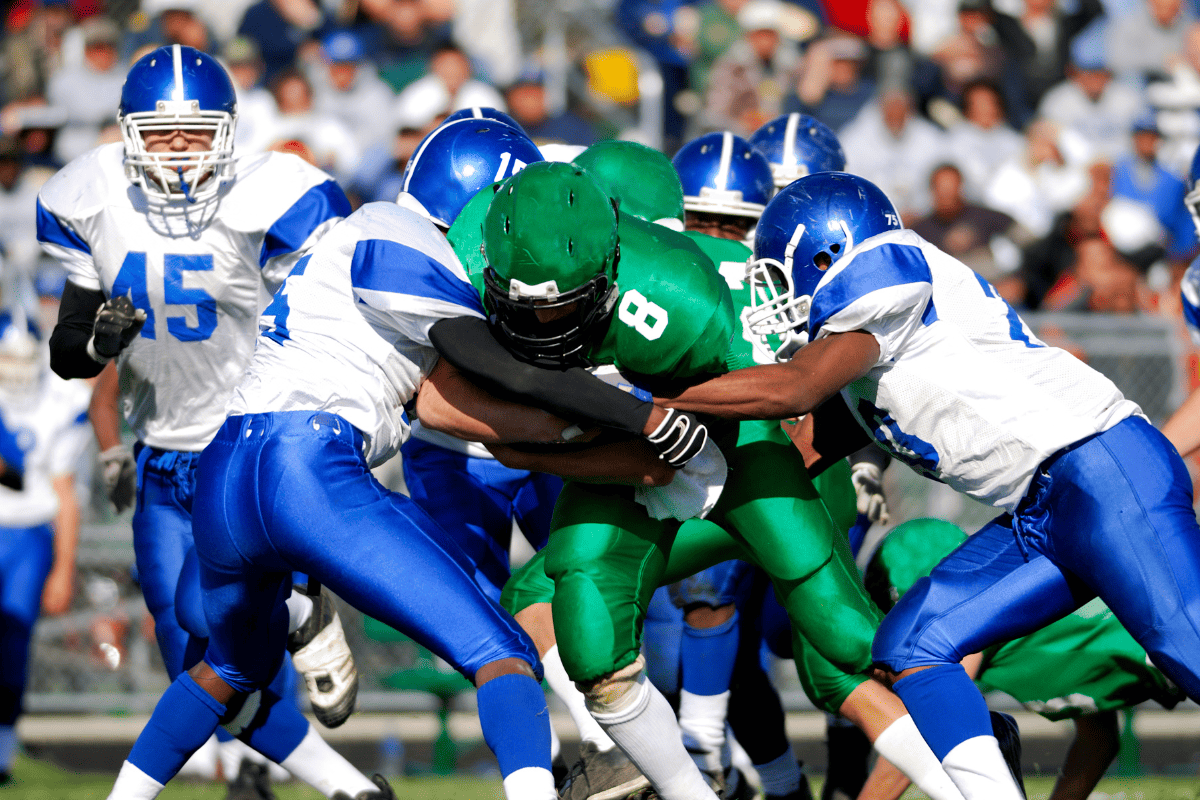What Does a Linebacker Do in Football? (Simply Explained)
In simple terms, a linebacker is a player on the defensive team who lines up approximately three to five yards behind the line of scrimmage. They serve as the “quarterback of the defense”, coordinating plays, reading the offense, and reacting accordingly.
The importance of the linebacker in football cannot be overstated. They serve as the backbone of the defensive unit, tasked with both defending against the run and protecting against pass plays.
Their versatility in taking on offensive linemen, tailbacks, and even wide receivers makes them pivotal in disrupting the plans of the opposing team’s offense.
Due to their central position on the field and the variety of responsibilities they shoulder, linebackers often heavily influence the defense’s overall performance. Their leadership, decision-making, and physicality are crucial elements in determining the success of a football team.
In this article, we’re going to look at what a linebacker does – their role, responsibilities and the skills necessary to play the position.
Role of the Linebacker
A linebacker, often referred to as the heart and soul of the defense, is a versatile player whose role bridges the gap between the defensive linemen and the defensive backs.
Positioned a few yards behind the line of scrimmage, their duties are multifaceted. They are responsible for both defending against the run, by tackling the ball carrier, and against the pass, by covering potential receivers and even rushing the quarterback.
Inside vs Outside Linebackers
Linebackers can be further classified into two primary categories: Inside Linebackers (ILB) and Outside Linebackers (OLB).
The Inside Linebacker, also known as the middle linebacker in a 4-3 defense, is often considered the leader of the defense. They are typically stationed in the middle of the field to control the action from sideline to sideline, reading the offense’s plays and making key decisions based on their observations.
Outside Linebackers, on the other hand, are generally positioned on the edge of the formation and have a broader range of responsibilities.
In some situations, they are required to rush the quarterback, in others, they must cover tight ends or running backs in pass coverage, and sometimes they must contain the run game by turning the play back towards the middle of the field.
Linebacker’s Role Based on Defensive Scheme

The role of linebackers can also change significantly depending on the defensive scheme employed.
For instance, in a 4-3 scheme (four defensive linemen and three linebackers), the linebackers are primarily tasked with covering potential receivers and defending against the run. The outside linebackers in this scheme typically have more coverage responsibilities, while the middle linebacker is often the main run-stopper.
Conversely, in a 3-4 scheme (three defensive linemen and four linebackers), outside linebackers are more frequently used as edge rushers, aiming to disrupt the quarterback, while the two inside linebackers are often left with the task of both run stopping and pass coverage.
The specifics of a linebacker’s role within these schemes can be highly dependent on the strategy of the coach, the skills of the players, and the nature of the opposition.
Key Responsibilities of a Linebacker
Stopping the Run:

One of the primary responsibilities of a linebacker is to stop the run. When the opposing team hands off the ball to a running back, the linebacker’s job is to prevent that player from advancing the ball. They do this by penetrating the offensive line, shedding any blockers, and then tackling the ball carrier.
In essence, linebackers serve as a second line of defense against running plays, providing crucial support to the defensive line. Their positioning on the field gives them a broad view of the developing play, enabling them to quickly react and move toward the action.
Pass Coverage:
Apart from stopping the run, linebackers also play a key role in pass coverage.
In this role, they are responsible for defending against short to medium-range passes by covering the offensive team’s tight ends, running backs, or even wide receivers. Linebackers must possess the speed and agility to keep pace with these receivers, as well as the ability to anticipate and react to the quarterback’s throws.
Blitzing:
Blitzing is a defensive strategy where linebackers, instead of covering potential receivers or watching for a run, aggressively rush or “blitz” the quarterback.
This tactic is generally used to disrupt a pass play, force a hurried and potentially inaccurate throw, or sack the quarterback. The decision to blitz can depend on several factors including the down and distance, the offensive formation, or the specific game situation.
Effective blitzing requires a linebacker to have both speed and power, as they must be able to move quickly into the other team’s backfield and get past anyone trying to block them.
Necessary Skills for a Linebacker
Physical Skills:

The position of linebacker demands a certain level of physical prowess.
First and foremost, tackling is crucial. Linebackers must be adept at bringing down opposing players quickly and efficiently.
Speed and agility are also vital – they need to be quick to react to plays, sprint in pursuit of ball carriers, and be nimble enough to navigate through the chaos on the field.
Finally, strength is a major component of a linebacker’s skillset. Whether it’s shedding off offensive linemen, taking down a power running back, or rushing the quarterback, the physical power a linebacker possesses can greatly influence their effectiveness on the field.
Mental Skills:
However, physical skills alone are not enough to make a great linebacker. The position also requires a deep understanding of the game.
Linebackers must be able to quickly read offensive formations, anticipate play calls, and react appropriately. This ability to diagnose plays often comes from meticulous study of game film and an understanding of opponent tendencies.
Furthermore, decision-making is a critical skill. During a game, a linebacker must make split-second decisions that could be the difference between a routine play and a game-changing moment.
Communication and Leadership:

Finally, communication and leadership are fundamental skills for a linebacker. Often regarded as the ‘quarterback of the defense’, a linebacker needs to effectively communicate the defensive play calls and make adjustments based on what they see from the offense.
Their positioning in the middle of the defensive formation allows them to see the entire field, making them key in directing teammates and coordinating plays. Beyond just communication, successful linebackers often exhibit strong leadership qualities, inspiring and guiding their team through their actions and attitude on the field.
Legendary Linebackers in the NFL
There have been many great linebackers over the years that have changed the way the game of football has been played. Here are just a few who stand out from the rest:
Dick Butkus:
Perhaps no discussion of great linebackers would be complete without mentioning Dick Butkus. Playing for the Chicago Bears from 1965 to 1973, Butkus was renowned for his fierce tackling and intimidating presence on the field. He was named an All-Pro eight times and was selected for the Pro Bowl on nine occasions.
Butkus left an indelible mark on the sport, setting the standard for future generations of middle linebackers with his aggressive playing style and relentless pursuit of the ball carrier.
Ray Lewis:
Ray Lewis is another name that stands out in the pantheon of legendary linebackers. A two-time Super Bowl champion with the Baltimore Ravens, Lewis was renowned for his leadership, intensity, and hard-hitting style. He won the NFL Defensive Player of the Year award twice and was selected to the Pro Bowl 13 times in his illustrious career.
Lewis’s incredible work ethic and his ability to inspire his teammates have helped shape the modern understanding of what it means to be a linebacker.
Lawrence Taylor:
Often credited with revolutionizing the linebacker position, Lawrence Taylor played his entire career with the New York Giants, leading them to two Super Bowl victories. Known for his speed and power, Taylor was a fearsome pass rusher who forever changed the way the outside linebacker position was played.
His aggressive style of play, marked by his ability to disrupt offensive plays in the backfield, has had a lasting impact on defensive strategies in the NFL. Taylor was a 10-time Pro Bowler and a three-time Defensive Player of the Year.
These legendary linebackers have not only achieved individual success but have also fundamentally influenced the way the game of football is played. Their impact transcends their personal records and has etched their names permanently in the annals of football history.
Final Thoughts
The role of linebackers in football is truly multifaceted and critical to a team’s success. Their duties range from stopping the run to covering passes and even rushing the quarterback.
The position requires a unique blend of speed, strength, agility, and tackling ability on the physical side. Mentally, it demands an in-depth understanding of the game, an ability to read offensive formations quickly, and the knack for making split-second decisions under pressure.
Linebackers often function as the heart and soul of a defense, providing leadership and guidance on the field. They are the communicators and coordinators, aligning their team in response to the constantly shifting scenarios presented by the opposing offense.

